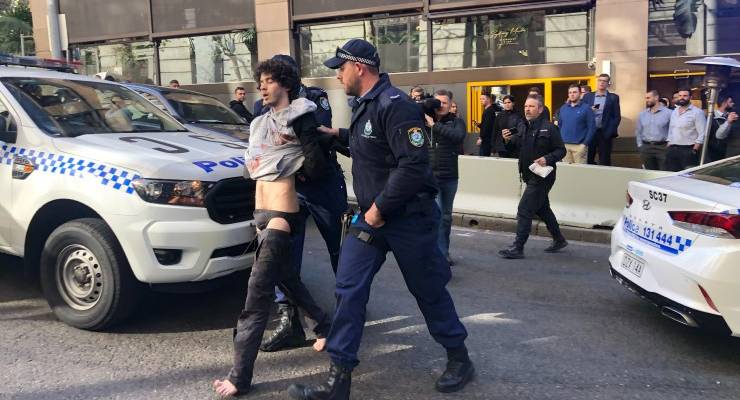
Mert Ney, the man who allegedly committed a knife attack in Sydney on Tuesday, poses a problem for the Australian media.
Ney has a documented history of mental illness and drug abuse, and reportedly left a psychiatric facility just days before the attack. But he also yelled the Arabic phrase “Allahu akbar” while brandishing a knife, instantly creating feverish speculation about possible links to radical Islam.
Ney’s sister confirmed the family was not Muslim (recent reports suggest the family is of Turkish-Cypriot background), and said Ney might have used the phrase to scare people. Police indicated that Ney had no links to terrorist groups, although found some evidence of an apparent fascination with mass killings including the recent white supremacist terror attack in Christchurch.
The rise of the terrorist frame
Despite Ney’s mental health issues and highly erratic behaviour, it was the terror angle that took off quickest. Within minutes of the attack, and with details still very much caught in the confusing fog of disinformation that inevitably accompanies such incidents, Sky News reporter Laura Jayes tweeted that Ney had yelled “Allahu akbar“, later confirmed on video.
That tweet was picked up by anti-Muslim Twitter accounts among others. Jayes has since written a piece defending the reporting, noting that it was “sensitive but crucial information”. “At that stage we had not heard from police. No one knew if the attacker was acting alone,” she wrote.
Crikey is not suggesting that Jayes intended to attract anti-Islamic sentiment.
Ney’s utterances were the focus of initial reporting, even as eyewitnesses described him asking to be shot by police, and footage showed him running straight at a moving car. Sydney’s Daily Telegraph went with the headline “Akbar attack(s) in Central Sydney” for an early online piece. The Australian’s rolling coverage described the incident as an “Allahu akbar knife frenzy”.

On Wednesday, the Oz’s headline described Ney’s “ideology of death”, and still led with his cry of Allahu akbar.
The easy dominance of the terror frame is sadly all too familiar according to Clarke Jones, a research fellow at the Australian National University’s School of Psychology.
“For people trying to explain it, [terrorism] is a comfortable fit for them. They want to box it into a particular explanation or particular corner,” he said. “The way the media has rallied around this incident in particular shows a desire to turn it into a terrorism event, and I think that is very unhelpful.”
Jones told Crikey he is worried about the way such reporting can reinforce negative perceptions of minority groups, particularly Muslims. In the hours after the attack, that concern came to bear when, despite explicit statements from police to the contrary, the terror angle spread through reactionary social media.
British far-right commentator Katie Hopkins falsely claimed police had confirmed the suspect was a “terrorist with Islamist ideologies”. Various alt-right figures like Avi Yemini and Paul Joseph Watson called the mental illness explanation into question. Tweets which included the phrase Allahu akbar got considerably more traction than those reporting other details about the attack, and social media was filled with Islamophobic posts and comments.
The problem with mental health
By now, a clearer picture of Ney’s struggles with mental health has emerged. But the focus on a perpetrator’s mental illness brings its own challenges. Firstly, the mental illness frame is not used equally.
“When it’s a white person it’s a mental health issue, whereas when it’s a Muslim person, it becomes a terrorism incident”, Jones said.
When “Bourke Street attacker” Hassan Khalif Shire Ali stabbed three people in central Melbourne last year, his family described a long battle with mental health and substance abuse. But in the aftermath, Prime Minister Scott Morrison called discussion of Ali’s mental health a “poor excuse”, instead focusing on the perpetrator’s apparent embrace of radical Islam. More recently, Donald Trump was criticised by psychologists for pinning the blame for the recent mass shooting committed by a white supremacist in El Paso on mental illness.
But there’s also the fear that reporting on perpetrators of lone-wolf attacks can be done in a way that stigmatises people with mental illness, especially when coverage tends to be sensationalised. Despite popular perception, people with a mental illness are no more likely to commit violent crimes than the general population, and are, in fact, more likely to be victims of violence.
“Very few people with mental health issues are also violent, so we’ve got to be careful drawing any connection between mental health and violence”, said Jones.
There is currently no evidence that Ney was influenced by any kind of coherent violent ideology. But even among killers who have been “radicalised”, there isn’t a strong link between mental illness and violence. A study of Islamic State-linked attackers in the west found a similar level of psychological instability as among the broader population. Another study found mental illness was just one of a complex interplay of factors that might contribute to radicalisation.
What did you make of the coverage of the Sydney knife attack? Write to boss@crikey.com.au and let us know. Please include your full name if you would like to be considered for publication.









This event graphically displays the intersection between mental health, societal-issues (motivations) and the security we all seek as members of a community. Our health systems are under pressure, they need increased funding to deliver resources across a range of service area – mental health being one, instead we get tax cuts and zero-tax franking credits – neither of which address health. Societal-issues of significance (extremism, extreme nationalism, climate change and single-issue matters like animal cruelty etc) provide a wide swath of agendas that unwell people can fixate on, be motivated by and react too, and, finally, community security, while desired and welcomed, can never be complete and all-encompassing. Individuals with few or no external contacts can and will be able to undertake acts with no warning. What we did learn yesterday was that the ‘UA93 affect’ (fight back in the face of terror) is alive and well in Sydney. When we can, we the public, will act and act decisively to resist acts of violence – even if it means at risk of our own safety.
I think the writer used the expression ‘lone-wolf’ once too often (or twice counting the headline).
It gives a macho image so for the same reason as referring to IS as daesh – it was a culturally specific insult – why not use ‘mad-dog’?
“At that stage we had not heard from police. No one knew if the attacker was acting alone,” she wrote.”
I really don’t think Laura Jayes defense line actually defends her choice – I read it and can only ask why she wouldn’t wait before she’d heard from the police in a situation like this? All she did was add more fear in the moment – that a larger attack could be happening – and in the long term she’s fed the racists.
Given it’s a commercial broadcaster who targets folks open to hearing from racists, I find it hard to see why we should accept she was just sharing ‘crucial information’ and not milking the clicks by giving Sky viewers the narrative they want.
You share a channel with Alan Jones and Rowan Dean (etc) you don’t deserve the benefit of the doubt when you feed the racists.
Well said. Her excuses are very weak and unprofessional.
The victimisation that is our underfunded mental health system spread to those not afflicted – in the acts of people needing help, like Ney.
“How good is tax cuts : rather than funding infrastructure like mental health care?”
mental health is not infrastructure – it is a health service
To which tax dollars could have been delivered : instead of giving them back; or in the case of franking credits, “given back” to people who hadn’t paid them in the first place.
“Soft infrastructure”?
Police have confirmed that Hopkins is a lizard in an idiot suit.